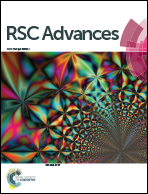Aliovalent-doped sodium chromium oxide (Na0.9Cr0.9Sn0.1O2 and Na0.8Cr0.9Sb0.1O2) for sodium-ion battery cathodes with high-voltage characteristics†
Abstract
NaCrO2 with high rate-capability is an attractive cathode material for sodium-ion batteries (NIBs). However, the amount of reversibly extractable Na+ ions is restricted by half, which results in relatively low energy density for practical NIB cathodes. Herein, we describe aliovalent-doped O3–Na0.9[Cr0.9Sn0.1]O2 (NCSnO) and O3–Na0.8[Cr0.9Sb0.1]O2 (NCSbO), both of which show high-voltage characteristics that translate to an increase in energy density. In contrast to NaCrO2, NCSnO and NCSbO can be reversibly charged to 3.80 and 3.95 V, respectively, delivering 0.5 Na+ along with Cr3+/4+ redox alone. The reversible chargeability to Na0.4[Cr0.9Sn0.1]O2 and Na0.3[Cr0.9Sb0.1]O2 is not associated with the suppression of Cr6+ formation. Both compounds show concentrations of Cr6+ that are higher than that of Na0.3CrO2, with an absence of O3′ phases. This implies that aliovalent-doping contributes to a suppression of the Cr6+ migration into tetrahedral sites in the interslab space, which reduces the possibility of irreversible comproportionation. NCSnO and NCSbO deliver capacities comparable to that of NaCrO2, but show a higher average discharge voltage (2.94 V for NaCrO2; 3.14 V for NCSnO; 3.21 V for NCSbO), which leads to a noticeable increase in energy densities. The high-voltage characteristics of NCSnO and NCSbO are also validated via density-functional-theory calculations.



 Please wait while we load your content...
Please wait while we load your content...